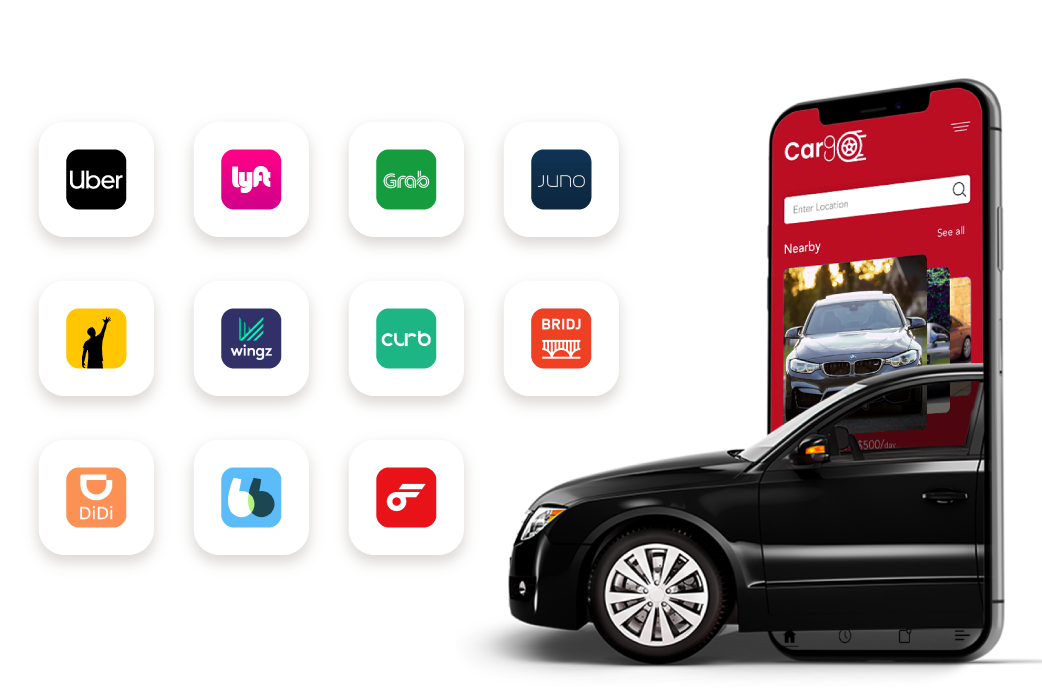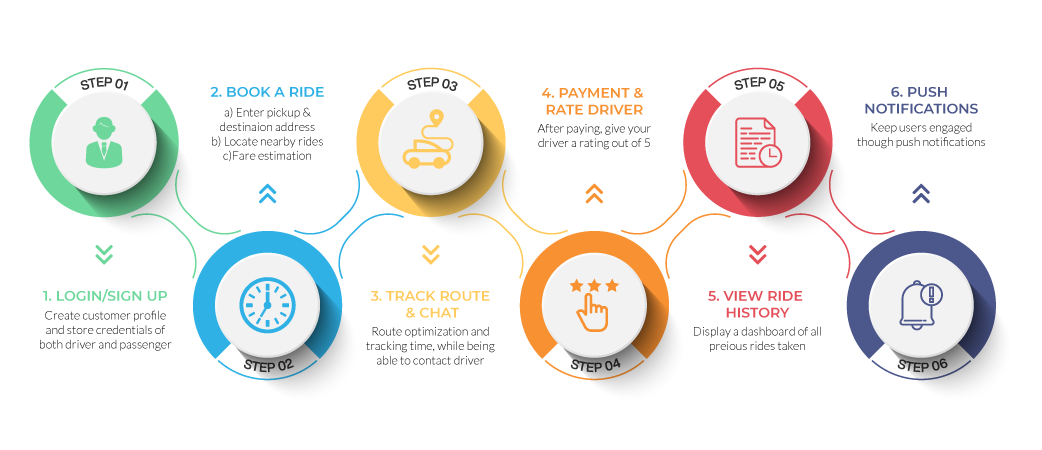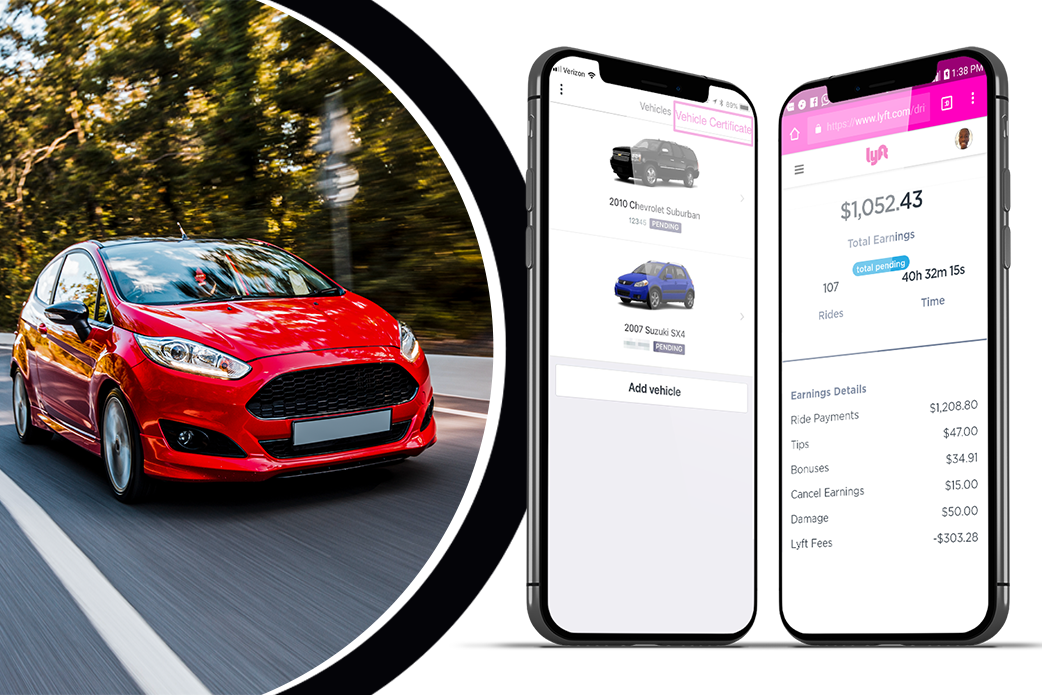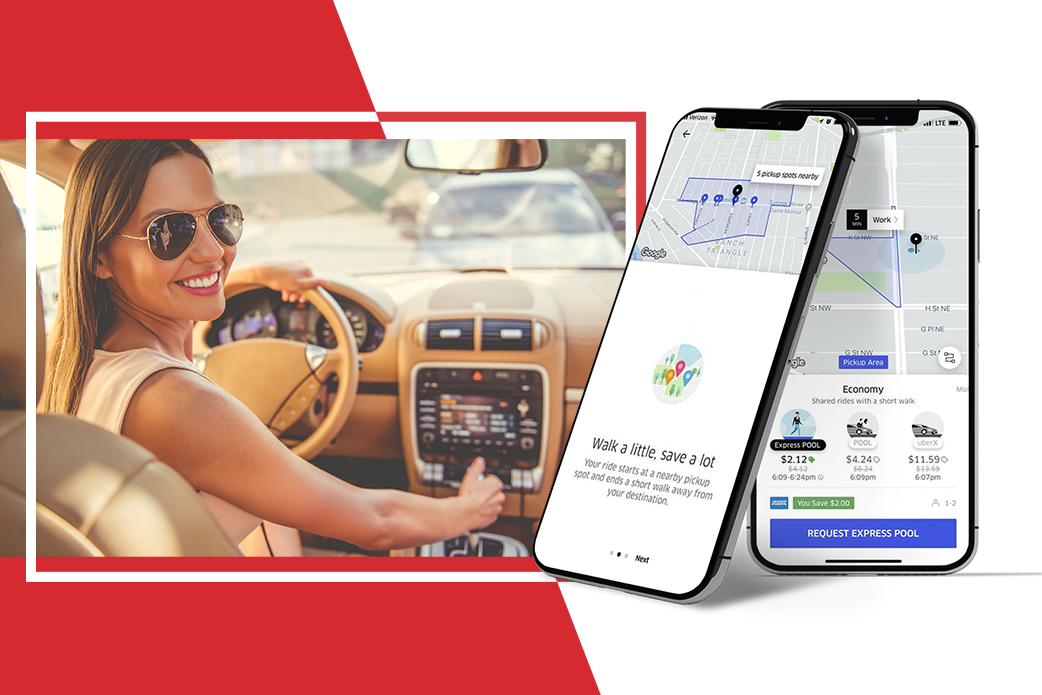How to Create a Ride Sharing App


Ridesharing has been well received worldwide due to its efficiency, cost-effectiveness and overall positive impact on the environment protection. The popular ridesharing apps (Grab, Uber, Lyft) have become widely recognized brands that provide perfect customer experience and deliver high-quality service.
When you decide to start a rideshare business, you are in for rapid growth since the rideshare market just keeps on getting more and more traction over the years.So, let’s find out what it takes to create your own rideshare app.
What Is Ride Sharing?
Ridesharing applications are quite different from regular taxi services that we are accustomed to. The main difference from a normal taxi service application is that ridesharing apps let you find fellow riders heading to the same destinations or sharing the same route. Ridesharing implies splitting the fare, which means that with ridesharing apps you achieve considerable cost-saving.
There are different types of ridesharing apps. In particular,
- Ride-sharing wherein the driver of rideshare vehicles can share the car with someone heading to the same destination.
- Carpooling is when a group of people alongside the driver ride to the same destination without paying a third-party
- Peer-to-peer carsharing wherein car owners have the option to have their cars rented for a fixed amount of time with a fixed rental fee.
The key players in the market of ridesharing are:
Uber, known as the biggest ride-sharing app in the industry worldwide, has different options for different target markets and needs. It has UberX, UberxL for those who need large vehicles. UberBLACK for luxury cars, and UberPOOL for multiple passengers willing to share a ride and fare.
Lyft is popular but operates only in the USA. Just like other ridesharing apps, Lyft has basic features such as price estimation, ride credits, and premium options for different target markets that use the ridesharing app.
Grab is the biggest rival of Uber in the Southeast Asia region. Grab has almost the same features as Uber. It offers different services such as GrabTaxi which uses regular cabs, GrabCar (it allows private cars to be used), GrabHitch (a social carpooling service), and GrabShare (on-demand ridesharing service where riders share the ride and the fare).

The Pros and Cons of Ride-Sharing Apps
Before you decide to create your own ridesharing app, you might decide to look into their advantages and disadvantages for passengers more closely.
Pros:
- Travel fare is more affordable
- Travel time is faster
- Rides can be planned in advance
- Fewer cars are on the road which helps reduce CO2 emission
Cons:
- Finding rides for every location you need to go can turn challenging
- Routes can differ depending on the routes that other passengers need to take
- You run the risk of meeting passengers whose behavior will not be to your liking (drunk, anti-social, etc.)
- Travel time may increase sometimes depending on how many passengers share the ride
How Rideshare App Works
The mechanism of the ridesharing app is as follows:
1. Requesting – it starts with a request made by a rider. Typically, the request is sent to the driver nearby.
2. Matching of Driver and Rider/s – the driver receiving the request will then have an option to accept or decline.
3. Ride Hosting – the passenger may opt to share the ride with other passengers who are looking for the same option. Hosting a ride may depend on routes, pick up, and drop off locations of all passengers.

4. Ride Commences – the ride may begin when the host accepts more passenger requests to share the ride.
5. Payment – there are cash and cashless options wherein passengers may choose which payment method is comfortable for them. The fares are split equally depending on the travel distance.
6. Rating – apps have the option to rate the driver and passengers. This rating affects both the rider and driver profiles and, in some cases, affects their ride-sharing options in the future.
User Roles and Feature List in Your Ride Sharing App
The main user roles of the app are the customer and driver. They are offered a different set of features within the app along with a dispatch system on an admin panel.
Customer App

- Registration – with an encrypted environment, this provides a safe space for customers to put their information and connect their social media accounts for accessibility.
- Finding a Ride – this feature helps customers see those who will take the same route for ride sharing. It also provides information and different options such as a preferred route, type of transportation, and type of travel (whether it will be shared with other passengers or a private ride).
- Real-Time Tracking – this allows the customer to locate the driver while receiving updates and notifications regarding the upcoming ride.
Location-based app development
- Payment System – this should enable the customer to register a credit/debit card as an option for cashless payment.
- Information About Other Passengers – this should allow passengers to see details or profiles of other passengers they will be sharing a ride with. With this feature, trust and security are built among passengers.
- Ride Cancellation – there should be a flexible interface wherein customers can cancel the rides while following the policies and guidelines. Cancellation fines can be added given that there is a proper time-frame imposition.
- Bad Experience Reporting System – a sense of security and good customer experience is provided when a feature allows the customer to report the inadequate service. This builds trust and despite the bad experience, customers will continue to use the application.
- Chat System – internal messaging or a chat system is important for instant communication especially when inconsistencies arise before the ride starts.
- Push Notifications – with this feature, customers are informed of all the details they will need such as ride status, car information, estimated time of arrival, and estimated travel time.
- Review & Rating – this allows the customers to rate and comment on their ride experience.
Driver App

- Registration – this should allow the driver to register easily and have their accounts secured.
- Acceptance and Rejection of Ride Requests – drivers should have the option to accept or reject a ride whenever they need to.
- Rider’s Trip Information – it is important to have the full trip details so that the driver is aware of the estimated cost and time spent. This also helps the driver decide whether it is worth accepting a ride or not.
- Navigation Systems – having GPS and mapping is important to ease drivers’ efforts and navigate the routes.
- Contact Passenger – contact information allows the driver to communicate with passengers directly.
- Receiving Payments – drivers can receive the payment for their service in cash or on a cashless basis depending on the option the rider chooses.
- Plan-Ups for the Day – Having a trip planner feature helps change the game for drivers especially when they can analyze hourly trends. Aside from that, they get notified of upcoming promotions and can set limits when needed.
Admin Panel

- Driver Management – with this feature, screening and approving new drivers, as well as processing payments are enabled.
- Vehicle Management – admins can check and screen if vehicles are at par with the company’s ridesharing set standards.
- Payment Management – this allows the admin to check commission rates for drivers and the number of total earnings.
- Ratings & Reviews Management – this helps the admin track the performance of drivers and app services through ratings and reviews from customers.
- Complaint Management – this aids in pacifying complaints and problems while finding a resolution. This is important for customer retention and loyalty.
- Earnings Report – this feature shows the trends in earnings and helps the management to get insights and improve business performance on a monthly basis.

- Dashboard – key statistics such as metrics, management, notifications, email templates are a few of the things admins see on this feature.
Advanced Features
These are optional features, but this makes the ridesharing app more attractive and efficient to use for ridesharing customers.
- SOS Button – having this feature builds a sense of trust and security not just for the riders, but also for the drivers. The rule ‘Safety first’ is best addressed with this advanced solution.
- Discounts for New/Loyal Users – offering promotions and discounts build retention for loyal customers and attract potential customers too.
- Schedule a Ride in Advance – having the ability to schedule a ride makes it more convenient for users and drivers especially when they use the app on a regular basis.
- Multilingual App – having a multilingual application makes it more convenient for a wide range of users. Aside from that, it adds to the app’s scalability.
- Mark Favorite Locations – when riders use the app and go to locations they frequent, it is convenient to be able to mark the locations so users do not need to type the location every time they book. By providing a hassle-free booking experience, the app is more likely to be favored in ratings.
- Add Tip to Drivers – having this feature not only helps the driver gain more income but builds their confidence and motivation towards working well with the help of the ridesharing app.
- Offline Mode – it is important that the app still works when the driver enters a low-network area to avoid any kind of challenges (from spotting the location to processing the payment).

Creating a Successful Rideshare App
The popularity of ride sharing app development stands behind the number of rideshare apps on the market. They are financially helpful both for customers and service providers. However, there are many things you have to consider prior to creating a ridesharing application.
Here are the important details you need to know:
- Discovery Phase – There are lots of ridesharing apps out there, and your app must have its own identity. Having a unique niche is important, given that this creates a new strategy while attracting potential clients. When creating your rideshare app, it is a must to align this app with your overall business strategy. The customers’ needs, together with your stakeholders’ expectations come with it hence the importance of choosing a rideshare business model. Among other factors, you need to give a thought to key partners, customer segment, key resource, distribution channel, cost structure, and revenue stream.
- Feature List – Features make your app more efficient and attractive to users. However, overloading the app with features may have the opposite effect. Hence, it is important to have the optimal number of features while paying special attention to unique features that your app might offer to the end-users.
- Wireframing and UI/UX Design – It is crucial to have an eye-catching, interactive, yet simple design that will attract the users of your app. The first step is wireframing wherein you build wireframes for the app screen that cater to the driver app, rider app, admin panel. This may be time-consuming, but it builds the foundations for the core functionality of the app.
- Development – First of all, there is the stage implying the back-end development: in particular, the dev team works on the app server, web server, and building the database. All the data that your ride sharing app works with is stored on a single database. This stage of the development process will determine the functional core of the app.Mobile app developers are responsible for developing visual elements of the app that users can see and interact with. If web app is required, the development process consists of database design, creation of admin panel, dispatcher panel, passenger dashboard.
It is important to note the technology stack that is essential in developing a ridesharing application:
Geolocation: Android – Google’s Location APIs, Google Maps Android API, Google Maps; iOS – CoreLocation framework, MapKit, Google Maps.
Push notifications and SMS: iOS – Apple Push Notification Service, Android – Google Cloud Messaging, SMS notifications – Twilio.
Payment integration: PayPal, Braintree, and Stripe
Backend: Node.js, Java, PHP
Cloud server: Amazon Web Services, Google App Engine, Microsoft Azure
Database: MySQL, SQLite, PostgreSQL, and MongoDB
How much does it cost to build a Rideshare app?
The cost of developing a rideshare app is determined by several factors:
- Choice of app development platforms (iOS, Android, or cross-platform presence)
- Employing the team that consists of the project manager, iOS developer, Android developer, Backend developer, Frontend developer, UX/UI designer, and QA engineer.
- Rates for hiring and working with team experts.
- The project tech stack.
Professional advice is key, do not hesitate to contact us at [email protected], and we will consult you for free on a cost estimate of your project.
Concluding Thought
Having access to the means of transportation is essential these days but not everyone can afford to have their private vehicle. Aside from that, people are more environmentally conscious and it is important that rideshare helps minimize CO2 emission by limiting vehicles on the road daily.
To further help you achieve customer satisfaction, you will need assistance in making the highly functional ride sharing app. The experts of our team can help provide consultancy details on your ridesharing app project regardless of its complexity.
FAQ
The mechanism of the ridesharing app is as follows:
1. Requesting – it starts with a request made by a rider. Typically, the request is sent to the driver nearby.
2. Matching of Driver and Rider/s – the driver receiving the request will then have an option to accept or decline.
3. Ride Hosting – the passenger may opt to share the ride with other passengers who are looking for the same option. Hosting a ride may depend on routes, pick up, and drop off locations of all passengers.
4. Ride Commences – the ride may begin when the host accepts more passenger requests to share the ride.
5. Payment – there are cash and cashless options wherein passengers may choose which payment method is comfortable for them. The fares are split equally depending on the travel distance.
6. Rating – apps have the option to rate the driver and passengers. This rating affects both the rider and driver profiles and, in some cases, affects their ride-sharing options in the future.
Development of a ride sharing application requires the following steps:
- Discovery Phase
- Define the set of required features
- Prototyping and wireframing
- UX/UI design
- Pick the best-suited platform and tech stack
- Build and launch an MVP
- Promote, grow and scale your product
Choosing the right software development company is a key factor in project success.
The main user roles of the app are the customer and driver. They are offered a different set of features within the app.
Customer App
- Registration
- Finding a Ride
- Real-Time Tracking
- Payment System
- Passengers Profile
- Ride Cancellation
- Chat System
- Push Notifications
- Review & Rating
- Registration
- Acceptance and Rejection of Ride Requests
- Rider’s Trip Information
- Navigation Systems
- Contact Passenger
- Receiving Payments
- Plan-Ups for the Day
Driver App
- Registration
- Finding a Ride
- Real-Time Tracking
- Payment System
- Passengers Profile
- Ride Cancellation
- Chat System
- Push Notifications
- Review & Rating
- Registration
- Acceptance and Rejection of Ride Requests
- Rider’s Trip Information
- Navigation Systems
- Contact Passenger
- Receiving Payments
- Plan-Ups for the Day
Build your ideal
software today

